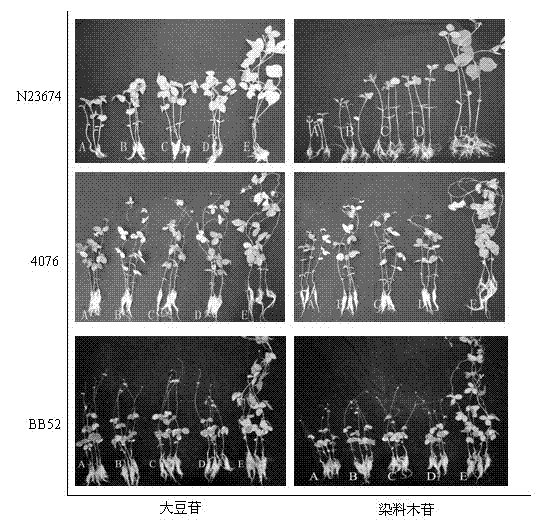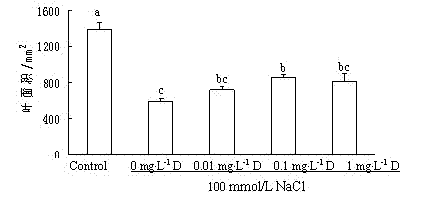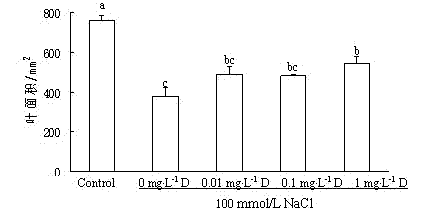Method for relieving salt injury of soybean seedlings by using exogenous soybean isoflavone
A technology of soybean isoflavones and seedlings, which is applied in alleviating salt damage to soybean seedlings, using exogenous soybean isoflavones to alleviate salt damage to soybean seedlings, can solve problems such as unclear relationships, and achieve obvious mitigation effects, obvious effects, and low cost Effect
- Summary
- Abstract
- Description
- Claims
- Application Information
AI Technical Summary
Problems solved by technology
Method used
Image
Examples
Embodiment 1
[0032]Weigh an appropriate amount of daidzin and genistin, dissolve them with a small amount of DMSO, and finally prepare a daidzin solution and a genistin solution containing 1% (V / V) DMSO, with concentrations of 0.01 mg / L and 0.1 mg / L and 1.0 mg / L. Soybean seeds were taken, soaked with the above-mentioned different concentrations of daidzin solution, genistin solution and 1% (V / V) DMSO solution respectively, and germinated after 10 hours in an incubator at 25°C. Take out half of the seeds soaked in 1% (V / V) DMSO solution, and germinate with deionized water (Control), and the other half of the seeds are germinated with 100 mmol / L NaCl solution (NaCl alone), and other treatments are germinated with 100 mmol / L NaCl solution. L NaCl solution for germination. For each treatment, those with consistent germination were selected and sowed in perforated plastic cups filled with quartz sand. Except that the control was placed in the turnover box filled with 1 / 2 Hoagland nutrient so...
Embodiment 2
[0034] According to the results of Example 1, 0.01 mg / L daidzin solution and genistin solution were selected for seed soaking treatment, and the seeds of each material were treated with 1% (V / V) DMSO solution and 0.01 mg / L daidzin solution respectively. , 0.01 mg / L genistin solution in a 25°C incubator for 10 hours, and then put it on a germination bed to avoid light to accelerate germination. Select the ones with consistent germination and sow them in a perforated plastic cup filled with quartz sand. / 2 Hoagland nutrient solution turnover box, cultured under suitable light and temperature, and the treatment solution was replaced every 2~3 days. When the first pair of true leaves grow out, transplant the seedlings to a foam board with holes, and carry out hydroponics in a turnover box filled with 1 / 2 Hoagland nutrient solution. When the seedlings grew to the first compound leaf, the materials soaked in 1% DMSO solution were divided into two groups, one group was the control (C...
PUM
 Login to View More
Login to View More Abstract
Description
Claims
Application Information
 Login to View More
Login to View More - R&D
- Intellectual Property
- Life Sciences
- Materials
- Tech Scout
- Unparalleled Data Quality
- Higher Quality Content
- 60% Fewer Hallucinations
Browse by: Latest US Patents, China's latest patents, Technical Efficacy Thesaurus, Application Domain, Technology Topic, Popular Technical Reports.
© 2025 PatSnap. All rights reserved.Legal|Privacy policy|Modern Slavery Act Transparency Statement|Sitemap|About US| Contact US: help@patsnap.com



